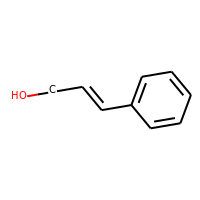
Cinnamyl alcohol
| Chemical identification | |
|---|---|
| Pubchem identifier | 5315892 |
| CAS identifier | 104-54-1 |
| DSSTOX identifier | DTXSID9041491 |
| IUPAC name | Cinnamyl alcohol |
| SMILES | C1=CC=C(C=C1)C=CCO |
| InChI | InChI=1S/C9H10O/c10-8-4-7-9-5-2-1-3-6-9/h1-7,10H,8H2/b7-4+ |
| InChIKey | OOCCDEMITAIZTP-QPJJXVBHSA-N |
| Synonyms | 2-Propen-y1-ol, 3-phenyl-; Propenoic acid, 3-phenyl-, (trans)-; 3-Fenyl-2-propen-1-ol; Cinmic alcohol; Styryl alcohol; Cinmyl alcohol; 2-Propen-1-ol, 3-phenyl-; Zimtalcohol; Styryl carbinol; 1-Phenylprop-1-en-3-ol; 3-Phenyl-2-propenol; Alkohol skoricovy; gamma-Phenylallyl alcohol; 3-Phenylallyl alcohol; 3-Phenyl-2-propen-1-ol; Styrone; Phenyl-2-propen-1-ol |
| Odor profile | |
|---|---|
| Odor classes | Citrus, Edible oil, Fermented, Floral, Herbs, Vegetable |
| Reference | [1] |
| Presence in Children's products | |
|---|---|
| Broad category | Diapering, Miscellaneous, Toys |
| Subcategory | Baby Wipes, General Baby products, Plastic Toys, Plush Toys, Scented Toys |
| Chemical classification based on ClassyFire | |
|---|---|
| Chemical kingdom | Organic compounds |
| Chemical super-class | Phenylpropanoids and polyketides |
| Chemical class | Cinnamyl alcohols |
| Chemical subclass | Not available |
| Natural source for the chemical | |||
|---|---|---|---|
| Organism | Kingdom | Genus | Family |
| Rhodiola rosea | Plantae | Rhodiola | Crassulaceae |
| Lamium album | Plantae | Lamium | Labiatae |
| Cinnamomum verum | Plantae | Cinnamomum | Lauraceae |
| Liquidambar formosana | Plantae | Liquidambar | Hamamelidaceae |
| Liquidambar orientalis | Plantae | Liquidambar | Hamamelidaceae |
| Narcissus tazetta | Plantae | Narcissus | Amaryllidaceae |
| Picea abies | Plantae | Picea | Pinaceae |
| Polygonum hydropiper | Plantae | Polygonum | Polygonaceae |
| Castanea crenata | Plantae | Castanea | Fagaceae |
| Reference | [1], [2], [3], [4] | ||